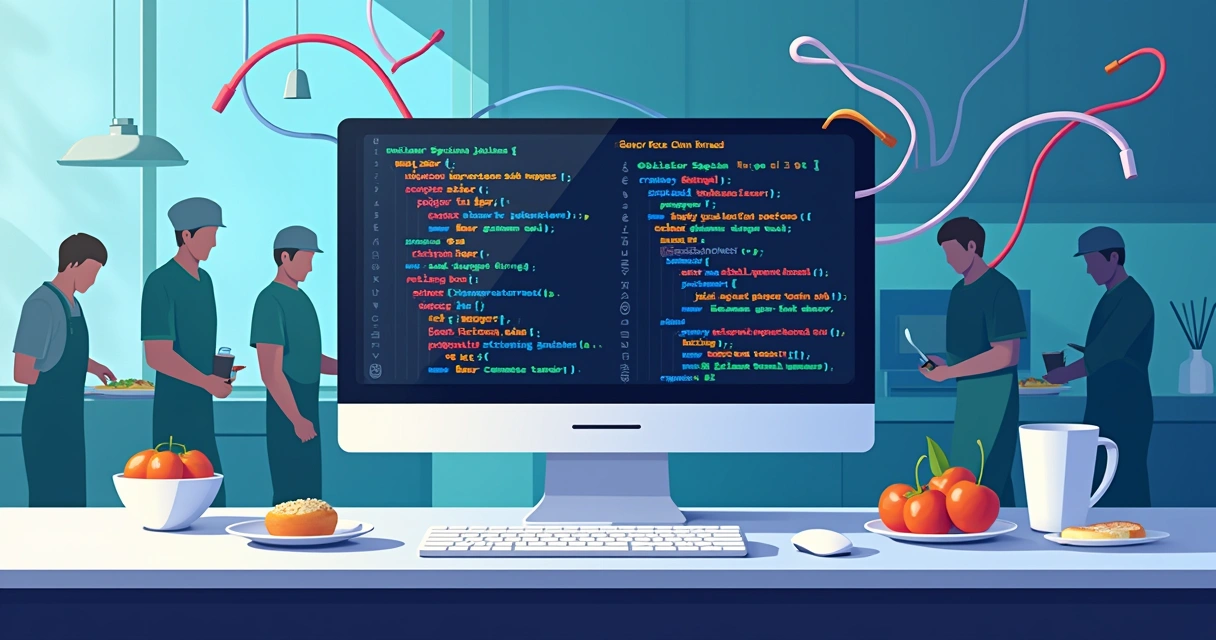
Introduction to adapting legacy Java code for virtual threads
Updating older Java code to use virtual threads can feel like a daunting task, but it opens up exciting possibilities. Think about it: traditional threads can handle only a limited number of tasks, often consuming a lot of resources. Virtual threads, however, are lightweight and can manage thousands of operations simultaneously with ease. This makes them perfect for applications dealing with many concurrent requests.
For example, a web server that currently struggles to handle high traffic could see a boost in performance by switching to virtual threads. This shift can streamline how your application manages resources, leading to faster and more efficient responses.
Getting started may require you to learn how your existing architecture interacts with threads. You can find useful guidelines in JEP 425, which explains the benefits of virtual threads in detail. Additionally, exploring the ExecutorService documentation will help you understand how to manage these threads effectively. And for a deeper dive into task management, check out ForkJoinPool.
By embracing this technology, you can enhance the efficiency and scalability of your applications, making them ready for the future.
 Understanding virtual threads and their significance in Java 21
Understanding virtual threads and their significance in Java 21
Virtual threads in Java 21 can really change the game when it comes to writing efficient and scalable applications. They allow developers to handle many tasks at once without using up too many system resources. This is particularly useful for programs that need to manage multiple users or requests, such as web servers.
Here are a few reasons why virtual threads matter:
- Increased Scalability: With virtual threads, you can easily manage thousands of operations concurrently, making your application more responsive.
- Lower Complexity: Writing code using virtual threads is easier than managing traditional threads. You reduce the need for complicated synchronization and can focus on the actual business logic.
- Gradual Adoption: If you have an older application, you can integrate virtual threads gradually, allowing you to maintain functionality while improving performance.
The introduction of JEP 428 is also significant. It brings structured concurrency to Java, making it easier to manage groups of cooperating threads. This feature, when combined with virtual threads, helps create new ways to handle concurrent tasks, similar to features in languages like Kotlin and Scala. The result is a more organized and maintainable codebase.
As you consider how to adapt your legacy Java code to use virtual threads (Java 21), think about the potential improvements in performance and simplicity. These advancements can truly empower your development process and enhance the quality of your applications.
Explore how to maximize these capabilities in your own projects, like those mentioned on byrodrigo.dev.
Benefits of using virtual threads in legacy Java applications
Using virtual threads in older Java applications can really change how you manage tasks. These threads are useful for handling many requests at once without using a lot of computer resources. This means your app can serve more users smoothly, which is especially important during busy times.
An important benefit is how they simplify your code. With traditional threads, you often have to deal with complex issues like locking and synchronization. Virtual threads allow you to focus on building your application instead. Think of it this way: instead of wrestling with complicated thread management, you get to work on what really matters—your code logic.
Switching to virtual threads doesn’t mean you have to overhaul everything at once. You can update your system gradually. This allows you to maintain the existing functionality while enhancing performance as you go.
Here are some benefits of using virtual threads:
- Better Resource Use: Virtual threads use less memory and CPU.
- Faster Response Times: Your application can handle requests more quickly, which improves the user experience.
- Maintainable Code: The simpler code makes it easier for teams to manage and expand on their applications.
For deeper insights, you might want to explore the documentation by Oracle, which shows how virtual threads improve concurrency management. These changes can help you build more efficient applications while keeping your codebase straightforward. So, if you’re wondering How to Adapt Legacy Java Code to Use Virtual Threads (Java 21), now is the right time to dive in!
 Creating REST controllers in Spring Boot with virtual threads
Creating REST controllers in Spring Boot with virtual threads
Working with legacy Java code can be challenging, especially when you want to modernize it. One exciting way to enhance your applications is by learning how to adapt legacy Java code to use virtual threads (Java 21). This approach offers a fantastic boost in performance and resource efficiency. Virtual threads are lightweight and allow for handling many concurrent tasks without the heavy cost of traditional threads.
Imagine your application managing numerous requests at the same time without slowing down. It’s like having a large kitchen staff that can prepare meals quickly. For example, instead of waiting for a database query to finish, your code can continue processing other requests. This means your users experience faster responses, which is always a good thing.
To implement this, start by identifying the parts of your code that could benefit from being non-blocking. Once you’ve pinpointed these areas, you can start rewriting them using virtual threads. Consider the resources available to you, and make sure that you’re still keeping the user experience in mind throughout the process.
For more insights on practical implementations, check the Spring blog. It includes valuable guidance on using virtual threads effectively in Spring Boot, highlighting how to create better-performing applications. Additionally, always think about security during your upgrades. You can find strategies for secure APIs in this guide. By adapting your code, you’re not just making it faster; you’re also future-proofing it!
Performance testing with JMeter for virtual thread applications
When dealing with older Java applications, transitioning to virtual threads can feel overwhelming. However, it’s an essential step towards modernizing your code and improving performance. Virtual threads allow your application to handle many tasks more efficiently, leading to less resource usage and faster response times. So, how do you make this switch?
Start by examining the existing code. Look for areas where you’re using traditional threads. These can usually be found in places where tasks are executed in parallel, like handling user requests or processing data. Once identified, replace these traditional threads with virtual threads. This transition is often straightforward and can dramatically improve the application’s scalability.
Next, testing is crucial. Use tools like JMeter to simulate multiple user requests. This step helps you see how your application performs with virtual threads in play. You might find that it handles the increased load much better than before. Monitoring important metrics such as response times and error rates provides insights into how your adjustments are working.
Keep in mind that optimizing legacy code isn’t a one-time task. As your application evolves, continuous improvement is key. Regularly revisit your code and test it to ensure it remains efficient as new features are added.
In conclusion, adapting your legacy Java code to use virtual threads can lead to significant improvements. By taking the time to make these changes, you’re investing in your application’s future, ensuring it runs smoothly and efficiently for years to come. This proactive approach will greatly benefit users and developers alike.
 Limitations of virtual threads in CPU-intensive operations
Limitations of virtual threads in CPU-intensive operations
When working with virtual threads in Java, especially when considering how to adapt legacy Java code to use virtual threads (Java 21), it’s important to recognize both their strengths and limitations. Virtual threads are great for tasks that spend a lot of time waiting, like I/O operations. However, they might not be the best choice for CPU-intensive tasks. Why? Because using too many virtual threads for heavy computations can slow down your application.
Here are a few points to keep in mind:
- Context Switching: If you have many virtual threads running heavy tasks, the system spends more time switching between threads, rather than doing the actual work. This can reduce your application’s performance.
- Memory Management: Virtual threads are lightweight, but if you create too many, they can use up a lot of memory. This leads to frequent garbage collection (GC) runs, which can slow everything down.
- Evaluate Task Types: Before diving into using virtual threads, consider the nature of your tasks. For example, if a task mostly waits for data from a database, virtual threads can be highly effective. But for intense calculations, traditional threads might work better.
Balancing the use of virtual and traditional threads is key. If you can blend these wisely, your applications will run smoother and handle different workloads effectively. For more insights on this topic, check out this article on Java 21 features.
Impact of Project Loom on concurrency management
Project Loom is transforming how Java developers handle concurrency. With the introduction of virtual threads, managing multiple tasks concurrently becomes easier and more efficient. Imagine writing code that looks simple and straightforward, much like regular code, but actually handles many operations at once. This is the promise of virtual threads.
Here are some important benefits you can expect:
- Simplified management: Virtual threads allow you to handle thousands of tasks without the heavy costs associated with traditional threads. This means less complexity in your code.
- Better performance: With virtual threads, your applications can use fewer resources. This leads to faster and more responsive applications, which is crucial for user experience.
- Gradual implementation: You don’t have to overhaul your whole codebase at once. You can gradually introduce virtual threads to improve the efficiency of your existing applications.
As part of this shift, the completion of JEP 444 brings us a refined approach to asynchronous tasks. This innovation is essential for building modern, scalable applications. Instead of relying on complex callbacks or thread pools, you can achieve straightforward, sequential code while still enjoying the benefits of concurrency.
In learning How to Adapt Legacy Java Code to Use Virtual Threads (Java 21), you’re not just adopting new technology—you’re preparing your applications for the future. Embrace the changes that Project Loom offers and watch your productivity soar!
 Best practices for adapting threading practices for virtual threads
Best practices for adapting threading practices for virtual threads
When thinking about improving your application performance, consider how to adapt legacy Java code to use virtual threads (Java 21). Making this shift can really enhance both speed and efficiency in your programs. Here are some user-friendly tips to guide you in this transition:
- Start with Small Changes: Instead of tackling everything at once, focus on small sections of your application. This allows you to test the waters and see improvements without overwhelming yourself.
- Measure Performance: Always keep track of how your application behaves after switching to virtual threads. Simple tools like JMeter can help monitor response times and resource use.
- Identify Blocking Code: Look for parts of your code that slow things down. By converting blocking calls to non-blocking ones, you can make the most of virtual threads.
- Understand Little’s Law: This law shows the relationship between latency, concurrency, and throughput in stable systems. Understanding it is crucial for optimizing your application using virtual threads. Check out more about it here.
- Simplify Management: With virtual threads being lighter, you can often simplify your code. This not only makes handling threads easier but also results in cleaner code overall.
Transitioning to virtual threads can boost not just performance, but also make your code more maintainable. Keep these tips in mind as you embark on this journey, and you’ll likely see impressive results.
Conclusion: Embracing simplicity and maintainability with virtual threads
Using virtual threads can transform your legacy Java applications and make coding much easier. Imagine handling multiple tasks without struggling with complex thread management. With the introduction of virtual threads in Java 21, you can finally say goodbye to those frustrating synchronization issues that often come with traditional threads.
Picture this: instead of creating a new thread for each task, you can use lightweight virtual threads that are simpler and consume fewer resources. This means your application can handle more requests without slowing down. Take a moment to think about how much easier your life would be if you could focus on writing meaningful code instead of wrestling with thread bugs. By adopting this new approach, you not only speed up development but also enhance the overall performance of your application.
Starting the transition to virtual threads doesn’t have to be overwhelming. Begin with small changes, observe the outcomes, and adapt gradually. As you get more comfortable, you’ll find that your coding becomes efficient and even enjoyable. For more insights on this topic, check out byrodrigo.dev. Embracing virtual threads might just be the upgrade your application needs!
 Frequently Asked Questions about virtual threads
Frequently Asked Questions about virtual threads
Learning virtual threads can really boost your programming skills. If you’re curious about how they work, consider how they can make your code simpler and more efficient. For instance, converting traditional multi-threaded applications might lead to performance gains. Exploring How to Adapt Legacy Java Code to Use Virtual Threads (Java 21) can guide you through this exciting transition.
Does Java 21 support virtual threads?
Java 21 introduces a game-changing feature called virtual threads. If you’re dealing with applications that handle many tasks at once, this is especially important. Imagine running thousands of lightweight threads without exhausting your system’s resources! This feature is particularly beneficial for web servers that manage numerous user requests simultaneously.
So, how do you get started with virtual threads? It’s straightforward! Java 21 provides updated APIs to help you transition smoothly from regular threads. You won’t just see improved performance; your code can also become cleaner and easier to maintain.
When adapting your code, consider how your existing structure works with traditional threads. Virtual threads can significantly enhance the scalability of your applications. For example, if you have a web service that processes a lot of simultaneous transactions, switching to virtual threads might make it far more efficient.
As you explore this new feature, remember that it can simplify your coding experience. For more insights on making the most of Java 21’s capabilities, check out resources available at byrodrigo.dev. You’ll discover practical tips that can help you easily adapt legacy Java code to use virtual threads.
How are Java virtual threads implemented?
Adapting your old Java code to use virtual threads can seem daunting, but it can actually bring significant benefits. Virtual threads are lighter and more efficient, allowing you to handle many tasks at once without the overhead of traditional threads. This means your applications can run smoother, especially when dealing with lots of I/O operations.
For example, imagine a scenario where your application needs to handle multiple network requests. With virtual threads, you can write your code in a straightforward way. Instead of blocking the entire application while waiting for responses, each request can run in its own virtual thread. This ensures resources are used effectively, keeping your program responsive and fast.
When transitioning to new virtual threads, remember that they are best for tasks that spend a lot of time waiting, like reading from a database or calling an API. For CPU-heavy tasks, sticking with traditional threads might still be wise. As you explore Java 21 and its features, consider how to incorporate virtual threads gradually. It’s a great opportunity to modernize your codebase while improving performance.
What is the difference between reactive programming and virtual threads?
Understanding the difference between reactive programming and virtual threads can really help you manage your Java applications better. Think of reactive programming as a way to handle events and data that come in at different times. For example, when a user clicks a button, you can react instantly without pausing everything else. This is great for applications that need to be responsive, like chat apps or live updates.
On the other hand, virtual threads introduced in Java 21 are like super lightweight threads. They let you run many tasks at once but with simpler code. Instead of dealing with complicated callbacks, you can write your code in a clear, straightforward way. For instance, if you’re handling multiple web requests, using virtual threads allows you to write it almost like regular code, making it easier to understand.
Choosing between these two approaches depends on what you need. If you want to focus on responsiveness, go for reactive programming. If clarity and ease of use are more important, virtual threads might be the better choice. Whichever path you take, both methods are powerful tools for concurrency in Java.
What is the difference between goroutines and virtual threads in Java 21?
When it comes to handling tasks in programming, goroutines in Go and virtual threads in Java have unique strengths. Goroutines are built right into the Go language, making it easy for you to create lightweight tasks that run concurrently. The Go runtime manages these tasks smoothly, allowing your programs to handle multiple operations without much fuss.
On the other hand, Java’s virtual threads, a feature from Project Loom, aim to modernize how Java deals with threading. They allow you to run thousands of lightweight tasks without the resource drain that usually comes with traditional threads. This means you can easily scale your applications without needing to manage complex thread pools.
For instance, if your app processes user requests, using virtual threads can help handle many requests simultaneously, making it faster and more responsive. As you learn how to adapt legacy Java code to use virtual threads (Java 21), you’ll find it aligns neatly with existing Java code, keeping things familiar and simple. Ultimately, whether you choose goroutines or virtual threads, both offer powerful ways to unlock the potential of concurrency in your applications.
What are the disadvantages of virtual threads in Java?
When diving into the world of Java 21 and its exciting virtual threads, it’s important to understand both the perks and the pitfalls. One key downside is their performance in handling CPU-bound tasks. If your application is deeply focused on heavy computations, traditional threads usually get the job done better. Why? Because switching between virtual threads can eat up time, slowing everything down.
Memory management is another area to watch out for. While virtual threads are lightweight, creating too many can backfire. This can lead to increased garbage collection (GC) activity, which may slow your application as the system clears out memory. Balancing the number of threads is crucial.
Consider the type of work your application does. Virtual threads shine with I/O-bound tasks, like waiting for data from a database. If your workload leans towards intense computations, it might be wiser to stay with traditional threads. Lastly, if you’re trying to adapt legacy code, be prepared for some hurdles. Not all parts of your application will benefit equally from this new approach. Remember, careful planning goes a long way in making the switch smoother.
What is the difference between virtual threads and CompletableFuture?
When it comes to improving your Java applications, understanding the difference between virtual threads and CompletableFuture is essential. Virtual threads, introduced in Java 21, offer a game-changing way to handle multiple tasks with ease. Imagine handling many user requests without the confusion of traditional threads. It makes your code cleaner and easier to understand. You can write your programs in a linear style, which saves you time and effort.
On the other hand, CompletableFuture helps manage asynchronous tasks. This means you can keep your application responsive while waiting for other tasks to finish. For instance, if you have a task that fetches data from the internet, you don’t have to wait for it to complete before continuing with your other work. However, the downside is that using callbacks can lead to complex code if you are not careful.
Choosing between these two depends on your project’s needs. If you prioritize simplicity and want to improve performance, virtual threads could be your best choice. But if your tasks are more about handling things in the background, consider using CompletableFuture. Understanding these options is key to effectively learning How to Adapt Legacy Java Code to Use Virtual Threads (Java 21).
Are virtual threads faster in Java?
When you think about modernizing your Java applications, you might wonder if using virtual threads is worth it. The beauty of virtual threads lies in their ability to handle many tasks at once, especially when those tasks involve waiting, like when you’re fetching data from the internet. Traditional threads can hog resources by staying idle while they wait, slowing everything down. With virtual threads, your application can serve multiple users more efficiently without running out of steam.
Imagine a scenario where your app needs to make several network requests. If you’re using traditional threads, each request could hold up the system, causing delays. On the other hand, virtual threads would let your application keep going smoothly, making the experience faster for everyone involved.
However, if your tasks are heavy on processing power, using virtual threads might not speed things up. For those CPU-intensive jobs, sticking with traditional threads could be smarter. Ultimately, the choice between them depends on your specific needs. If you’re curious about how to adapt legacy Java code to use virtual threads (Java 21), understanding these differences is the key to making your applications both efficient and modern.






